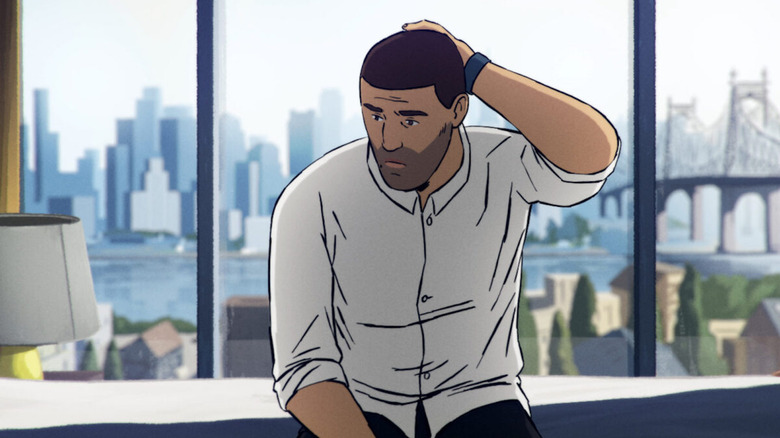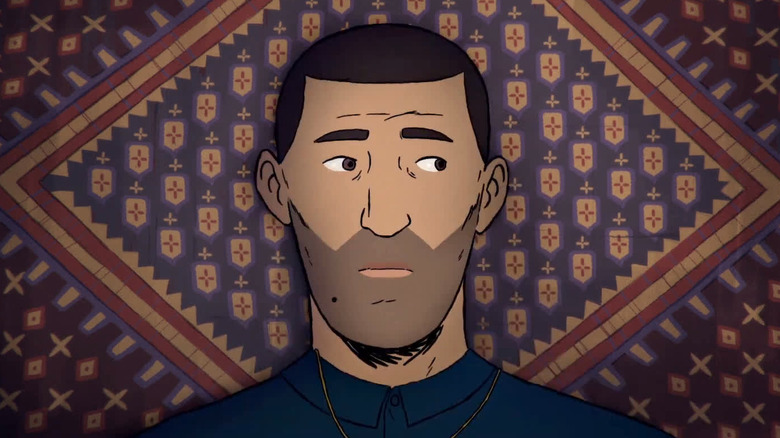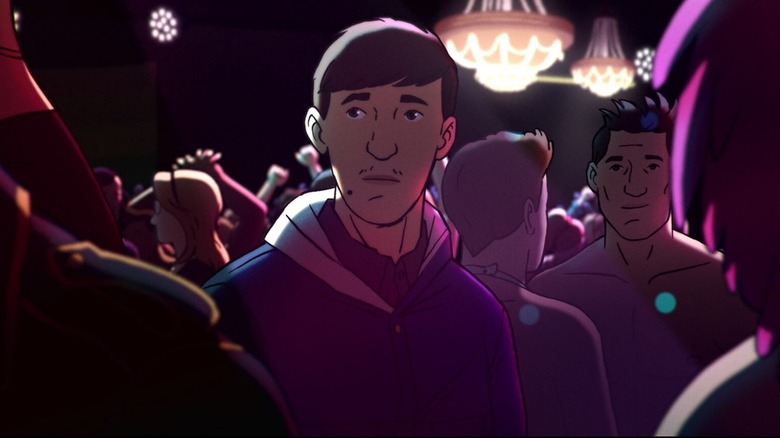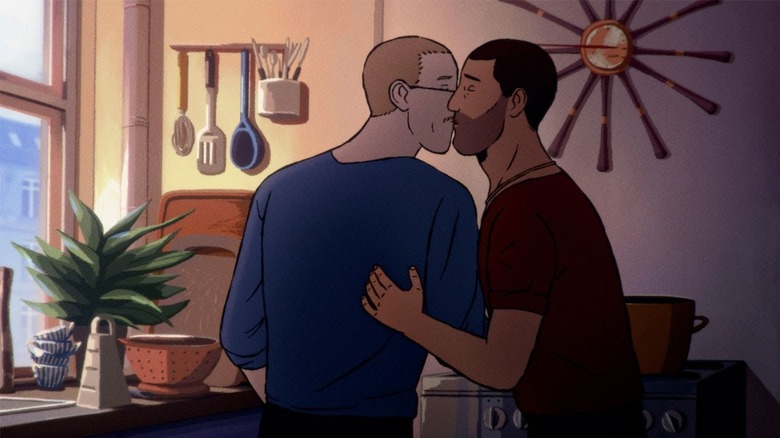Flee Review: Animated Documentary Paints A Refugee Tale More Vivid And Sharp Than Reality
Jonas Poher Rasmussen was 15 when he first saw a timid-looking Afghani boy on his local train ride to school. The boy, Amin, caught his attention for a number of reasons: In his sleepy Danish town in the 1980s, there weren't a lot of Afghani people at all, let alone teens who appeared to be living on their own. But he was most struck by Amin's style — cool, edgy, and bold, as if to dare you to look at him, at a time when immigrants dare not be noticed. It was these things that led Poher Rasmussen to approach Amin and strike up a lifelong friendship. But even as they became fast friends, Poher Rasmssen wouldn't learn the true story of how Amin, a refugee from Afghanistan whose family had all died tragically, ended up on his own in Denmark for many, many years.
Amin's story is what led Poher Rasmussen to write and direct "Flee," an animated documentary that turns Poher Rasmussen's confessional-style conversations with his longtime friend into a staggering refugee tale. Born out of Poher Rasmussen's respect for Amin's anonymity, the simplistic animation seems crude at first, but takes on a life that at times feels more vivid and sharp than reality itself. The flat hand-drawn animation with characters and backgrounds that almost appear hastily scribbled, lend the film a stream-of-consciousness feeling, as if the animation is catching up with Amin's words. Or better yet, Amin's words manifest them into being. It's rare that you see the medium utilized to this degree and with this level of skill — as if the animation has sprung from Amin's teen mind itself in a pop-art-meets-comic-strip form.
Animation as Anonymity
But why the anonymity? It takes a long time for Amin to make his confession, and the film breezes through his recounting of an idyllic childhood full of open courtyards and exciting stories told by his pilot father. But then he hits a wall. Amin gets up from the couch he's lying on, where Poher Rasmussen is filming him from an eagle-eye view. He rustles through an old box, where he finds the diary he kept as a teen. In a clear but halting voice, he reads aloud the tragic circumstances that befell his family: his sister raped, his siblings murdered, his mother and father viciously killed, him alone surviving. It's an upsetting tale, and even more upsettlingly, a familiar tale, one that many refugees fleeing from Afghanistan amid its years of political upheaval have experienced in some form or another. But, Amin reveals, it's not the whole tale. In fact, it's not his story at all.
There's a thin line that documentaries walk between evocation and exploitation — in movies we crave a narrative, a story; and reality isn't always as simple as that. To reduce someone's life into a series of twists and revelations is something that many an acclaimed documentary has been accused of, not to mention the countless true-crime docuseries that have no qualms about stepping over that line. So there's a deep sense of unease that proliferates the first few minutes of "Flee," as it builds to this so-called revelation. But despite the artifice afforded by the feature film structure, not to mention the semi-escapist nature of animation, "Flee" is as clear-eyed as could be in its unveiling of Amin's true story.
Amin's flight from Afghanistan didn't necessarily play out as he said, nor as he had led Poher Rasmussen and the rest of their circle to believe for decades. His father had been arrested by Mujahideen officials, never to be seen again, but his mother and siblings were very much alive. They had fled together to Russia, where they resided illegally, waiting until his older brother in Paris to rustle up enough money to smuggle them out. But the fear of being discovered, and the horrible, dehumanizing hardships they suffered while trying to leave Russia, left deep invisible scars on Amin, who spent the rest of his life in fear of being found out. He was never done fleeing, and even now, as an adult engaged to a man who only wants to buy a house and start a new life with him, he wants to flee again.
Animation as Artistry
These confessions all come tumbling out of Amin in his meandering conversations with Poher Rasmussen, which play out as part therapy session, part historical chronicle, part timid coming-of-age drama. Because it's not all tragedy that consumes Amin's life — "Flee" has its moments of vivaciousness and cheeky '80s teen rebellion, especially in the slow dawning of Amin's sexuality. He realized from a young age that he was gay, clued in by his obsession with his Anil Kapoor cigarette card and Jean-Claude Van Damme poster. As Amin describes how Van Damme would smolder at him through his grainy '80s VHS tapes, the animated version of the actor appears to wink and flex his muscles, his eyes twinkling more than it ever could in real life (no offense, Van Damme).
Because the animation in "Flee" acts as more than a veil to conceal Amin's identity. It's also a stunning show of artistry from Poher Rasmussen, who is one of the few filmmakers to see the potential of animation as more than just a novelty for the documentary film, but a tool with which he can create a fuller, more richly realized depiction of his friend's life. Amin proves to be an incredible storyteller, and Poher Rasmussen's animation does justice to this, dousing his nostalgic recollection of his middle-class childhood in Kabul in warm pastels, and rendering his worst, most terrible memories in black-streaked charcoal, which dash in a panic, like half-remembered ghosts, across the mostly blank backgrounds. Poher Rasmussen intercuts this with archival news footage of the Afghan war and Perestroika-era Russia, grounding the film in reality and creating a haunting, and imperfect, and electric tapestry. Comparisons will be drawn to both the film and comic book versions of "Persepolis," similarly a coming-of-age tale set against a contemporary war-torn background that is given new life by animation, and that's not bad company to be in. But there's a naturalistic quality to "Flee" that sets it apart, even as it briefly takes one out of the story.
Drawing Out the Details
After "Flee" has toggled back between past and present for a while, Amin gets up from the couch with a sigh, and leaves to the kitchen, where he chats with Poher Rasmussen, the mic picking up snatches of the hushed conversation. It's in these little details — the camera sitting still as we only see half of Amin's back while he mumbles about his fears, thumbing a gold necklace he always wears (whose origins add a heartbreaking layer to Amin's coming-of-age tale), as we hear the sounds of dripping water and rustling leaves — that makes "Flee" feel even more alive and intimate, long after the more stylistic flairs have faded.
Because "Flee" is more than gawping at a tragic refugee tale. At one point, Amin recalls a failed smuggling attempt out of Russia, which left him and a group of strangers stranded on a small boat and dying of thirst. They're overjoyed to be discovered by an ocean liner and ecstatically wave and cheer at the passengers ... until Amin realizes that they are tourists taking pictures at these apparently pathetic refugees. He falls silent in shame, a shame which he has difficulty shaking even now.
But "Flee" never shames its central character, only offering him the humanity and the understanding that he long craved. The film is as much a source of insight for us as it is an outlet for catharsis for Amin to embrace those parts of his life that he had long hidden, and to finally be rid of his ghosts.
/Film Rating: 9 out of 10



